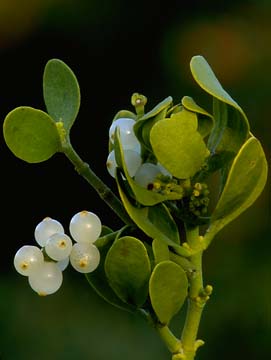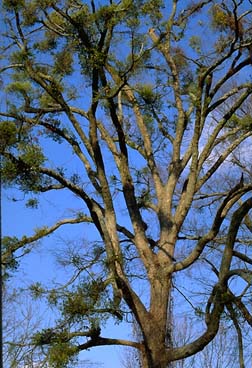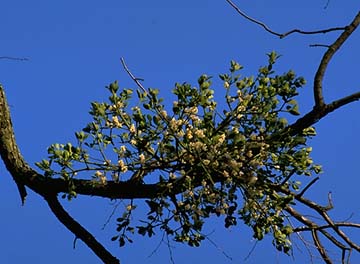


Department of Environment and Conservation
![]()
Myths and Lore of Mistletoe
By Andrea Brewer Shea and David Duhl
Photos by David Duhl
Mistletoe and Christmas. What other holiday tradition brings such a smile to the faces of men and women of all ages?
It wasn't always this way.
For at least 3,000 years, mistletoe was gathered in midsummer and was burned as part of a Celtic ritual.
Mistletoe was considered sacred by virtue of its occurrence on oak trees (a rare occurrence in Europe), a sacred tree and a symbol of strength and immortality.
The plant was ceremoniously cut with a golden sickle by Celtic priests and caught on a white cloth so as to avoid touching the ground. This ceremony coincided with the winter solstice and thus began the winter celebration.
Mistletoe was also used to welcome the new year and to ward off evil. Mistletoe was hung over a baby's cradle to prevent theft from fairies, and it was believed that mistletoe promoted dreams that unlocked the secrets of immortality.
When hung in the home, mistletoe symbolized purity and strength and promoted happiness, romance and peace. In fact, custom called for enemies meeting beneath the mistletoe to throw down their weapons and embrace.
Mistletoe also was believed to possess medicinal properties. When worn, mistletoe had the extraordinary powers of warding off demons and witches while protecting the wearer from fits, fever, tremors and poison. On top of all that, it was thought to promote fertility. It was even used as a treatment for convulsions and nervous disorders (even though mistletoe is very poisonous!). It also had some use as a vasodilator and sedative until the 1950s. Modern medical research has shown that mistletoe has promise for treating some cancers, hypertension, vertigo, epilepsy, palsy and cardiovascular ailments. Research has also confirmed that it is, in fact, very poisonous, so alternatives were developed and mistletoe--the miracle drug--disappeared.
Because of its association with pagan ceremonies, mistletoe was banned from Christmas ceremonies by the Church.
A common medieval belief held that mistletoe was the wood used to make the crucifix. Cursed, mistletoe was no longer welcome on earth and was doomed to live as a parasite growing on trees. It was not until the 17th century that people became more open about their fondness for mistletoe. Kissing under the mistletoe came about because of the belief that mistletoe's curative powers would cure a broken heart and soothe the differences between quarreling lovers.
Mistletoe is primarily a tropical plant, some growing up to 30 feet tall. The mistletoe of Christmas tradition grows in Europe and Asia, and a dwarf mistletoe, one of the world's smallest vascular plants, can be found in some conifers of Western North America. In Tennessee, only one mistletoe species is common, Phoradendron leucarpum.
Mistletoe is a thief. It's scientific name, Phoradendron means "thief of the tree" in Greek. To understand why, look at the life of American mistletoe. Mistletoe is semiparasitic; that is, while it has green leaves that provide some energy, it meets many of its energy needs by sucking the life blood from its host, usually oaks, elms and poplars.
The roots of the mistletoe never reach the ground. Roots enter the host tree, robbing it of necessary water and minerals. Actually, mistletoe has developed a very specialized tissue with the shape of a bell (called a haustorium). This bell-shaped structure grows into the host tree and combines with the living tree. Mistletoe survives by starving the host tree, sometimes to death. For this reason, mistletoe is sometimes known as "the vampire plant."
In addition to a host tree, mistletoe needs a way to pollinate its flowers and a way to spread its seeds to the branches of trees. While insects pollinate mistletoe, spreading of the seeds is a most interesting process. In Europe, the mistle thrush bird carries the very sticky one-seeded fruits to other host trees. Then, after consuming the berries, it regurgitates the seeds into branch crevices--an excellent place for mistletoe seeds to germinate.
In North America, birds avoid the immature fruits which are bitter, hard and contain poisonous compounds. Instead, they eat and disperse the mature fruits which are still hard to digest. The resulting unharmed seeds take root in the new host tree.
In Australia, mistletoe fruit is winged and is dispersed by the wind. And dwarf mistletoe may have the most interesting means of seed dispersal of all. The fruit seems to be explosive; the sticky seed, shaped like a small missile, may travel up to 60 feet at speeds of up to 80 feet per second before sticking to a new host! In fact, a product called bird lime, a sticky substance smeared on trees to catch birds, is made from the berries of mistletoe.
After the seed lodges in the new host tree branch, it grows into a yellowish-green plant up to three feet long. Its dense leathery oval- to lance-shaped opposite leaves (about two inches long) mask the small pale flowers that appear in compact spikes (male and female flowers are found on different plants). The plants grow slowly and generally survive as long as the host does.
Every year, mistletoe is collected and used as a Christmas ornament, and every year, children and family pets become ill from the poisonous berries. We don't use mistletoe to ward off baby thieves or to promote dreams of immortality anymore. For some reason though, kissing under the mistletoe has survived through the ages; it probably will for a long , long time, too.
(With the TDEC's Division of Natural Heritage, Andrea Brewer Shea is endangered species coordinator and David Duhl is manager of the Tennessee Rivers Assessment Project.)
 Mistletoe is easiest to find in the winter months when the leaves of the host tree are absent..... |
 It spreads when the berries are eaten by birds and dispersed. |
 Mistletoe grows as dense evergreen clusters on oak, elm and poplar trees. |
Updated October 20, 1997; Send comments to Department of Environment and Conservation.